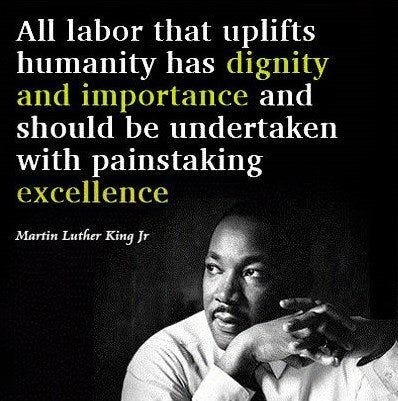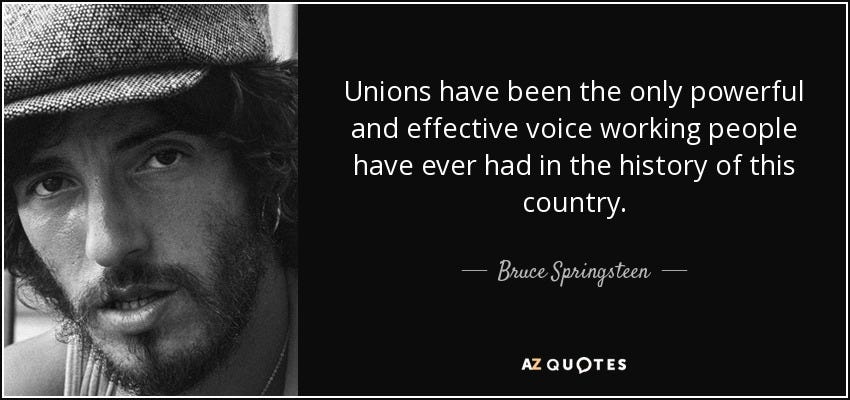How Can Unions Be Resurgent When Membership Rates Are at an All-Time Low?
Confessing my journey out of union skepticism. And a new playlist.
I was raised in a decidedly pro-labor household. In fact, my parents claimed to have been blacklisted during the McCarthy era. I never understood what they were blacklisted from — my dad was a hardware salesman and my mom a bookkeeper. Was J. Edgar Hoover hot on the trail of the guys restocking spackle on the shelves of Sal’s Hardware store? (Maybe.)
Despite being raised one way, I grew up another — ambivalent about unions. I knew they’re the reason most Americans have eight-hour workdays, weekends, child labor laws, and safety standards, but I also knew their history of corruption and unsavory alliances.
HR Has Entered the Chat
Then I started working in and around Human Resources departments. There, I sometimes witnessed a disdain for labor that switched a light bulb on for me.
At a breakfast meeting of a health care organization’s HR division, for example, the CEO, a guest speaker, literally stood on a chair — with a chocolate chip muffin in one hand — and pridefully bellowed to a rapt audience (including those of us in front getting sprayed by half-chewed muffin) about how he’d successfully mobilized a “war room” to stave off an attempt by nurses to organize.
Embedded in HR, I came to see that some employers, with HR foot soldiers running point, were affronted by their workers’ expectations of a fair deal.
The fact that HR experts, authors, and business leaders prattle on about belonging and teamwork, while doing everything they can to squelch unity, exemplifies the depth of the charade. They stirringly tweet allegiance to DEI, while thwarting one of the most effective instruments for reducing workplace inequity — collective bargaining.
Employer virtue signaling implodes when confronted by united workers, as we’ve seen in companies like Amazon, Starbucks, Trader Joe’s, and REI — previously hailed as “conscious capitalism” flagbearers, now exposed stifling employee voice to varying degrees on a spectrum that ends in unlawful union busting. (Standout: Microsoft adopted a neutral position when some employees unionized.)
This past Monday was Labor Day in the US and Canada. (Many European countries celebrate Workers’ Day around May 1st; Australian states and territories choose their own adventure, some celebrating labour in March, others in October.)
In the US, the holiday — intended to honor American workers and the labor movement — is best known as a weekend for barbecuing, waving flags, and buying mattresses at a 30% discount (no money down!). Imagine if Labor Day received the same attention as, say, Veterans Day or Martin Luther King’s birthday.
Despite leaders’ efforts to keep the meaning of Labor Day under wraps, news reports in recent years portray organized labor as resurgent. Stories abound about workers organizing and/or about work stoppages (or looming strikes) at Amazon, Starbucks, Chipotle, Trader Joe’s, Apple, and UPS, and among members of graduate student organizations, United Auto Workers, SAG-AFTRA, and the Writer’s Guild, to name a few.
How can unions be resurgent, when union membership rates are at an all time low?
If my Substack data tells me anything, it’s that you, dear readers, don’t like me droning on about data. But a promise is a promise. Lemme just hit you up with a few key bullet points, supplemented with links to more detailed resources for my fellow nerds. (Option B: Jump straight to the Labor and Working Life playlist.)
⬆️ Union Membership Is Up
Economists consider union membership rates a key measure of bargaining strength.
The union membership rate — aka union density, the percent of workers who are members of unions — reached an all time low of 10.1% in 2022, down from 10.3% in 2021.
The number of union members, 14.3 million in 2022, grew by 273,000 during the same period.
How did the number of union members increase while the union membership rate went down? Simply put, during this period, the number of non-union jobs spiked. In other words, union members represented a slightly larger slice of a much bigger pie. While union membership is not resurgent, it did edge up in 2022.
⬆️ Union Favorability Has Trended Up Since 2009
Public approval bolsters union strength.
A 2022 Gallup survey showed that US approval of unions was higher than it’s been in more than 50 years, and rose steadily over the previous 13 years. Last week, Gallup released new data, reporting, “The 67% of Americans who approve of labor unions today is down slightly from 71% a year ago but marks the fifth straight year this reading has exceeded its long-term average of 62%.”
Pew Research reports most Americans agree low rates of union representation are a bad thing: “U.S. adults say the large reduction over the past several decades in the percentage of workers who are represented by unions has been somewhat or very bad for the country (58%) and for working people (61%).”
⬆️ Labor Activism — Lowkey Resurgent
The “resurgence” we hear about refers mostly to labor activism.
Here’s a little-known factoid about work stoppages (which include strikes by workers and lockouts by employers, but lockouts are uncommon these days): The Bureau of Labor Statistics has systematically tracked these since 1947. In 1980, however, as a result of budget cuts, BLS started tracking only “major” work stoppages affecting 1000 or more workers. This is a big deal; work stoppages at a lot of retail workplaces, for example, are omitted from the official data.
To the rescue comes Cornell School of Industrial and Labor Relations, which in 2021 started compiling its own data on work stoppages, pointing out that “only recording very large work stoppages excludes the vast majority of strike activity and leaves practitioners, policymakers, and scholars misinformed…”
The Cornell Labor Action Tracker found the total number of work stoppages increased by approximately 52% (279 to 424) from 2021 to 2022. (BLS reported only 23 “major” work stoppages in 2022.) The number of workers participating in stoppages increased by approximately 60%.
When the final data is tabulated, the number of workers involved in stoppages this year will blow 2022 out of the water, especially if UAW’s 146,000 workers strike. Cornell already has recorded 251 work stoppages this year, according to a report in the New York Times.
In its fiscal year ending September 2022, the National Labor Relations Board saw a 53% increase in union election petitions, with the spike maintaining momentum in the first six months of this year. (Reality check: NPR reports that unions won fewer than half of last year’s elections.)
🌐 Union Density in Canada, Europe, Australia
Compare to the US 2022 union membership rate of 10.1%…
Canada: 29%
UK: 22%
Australia: 13%
EU: Union membership varies widely across the European Union and uses varying methodologies that make comparisons unsound. According to the OECD, the most recently recorded membership rates range from 67% in Denmark, 65% Sweden, and 58% in Finland… to 26% in Ireland and 13% in Spain.
Are unions resurgent?
In a podcast interview Cornell Labor Action Tracker director Johnnie Kallas notes that labor activism, like membership rates, are nowhere near what they were in the mid and late 20th century. “In the 1970s,” he says, “an average year had about 5000 work stoppages involving close to 2 million workers.”
But he also notes that the last few years have seen a significant increase in labor activism, especially since 2018.
Consider: In the middle of 2021, there were no unionized Starbuck stores in the US. Today, more than 8500 employees have union representation at 350+ stores. UPS recently averted a strike by agreeing to an historic union contract. Actors and writers are walking picket lines right now.
United Auto Workers and Big 3 automakers have one week to negotiate a new contract. A strike is likely.
Songs About Labor and Working Life
Growing up, the closest my family got to a house of worship was a Pete Seeger concert at Carnegie Hall. In that spirit, here’s my playlist of music about labor and working life, featuring genres like hip hop, rock & roll, indie, punk, reggae, country, and folk.
New York Times Gift link
(No paywall through September 18, compliments of Heigh Ho)
A Summer of Strikes — Work stoppages in the United States this year could reach heights rarely seen in recent decades.
Resources
Labor Unions and the Middle Class; US Department of Treasury; 2023.
Have We Forgotten the True Meaning of Labor Day?; Zagorsky, J; The Conversation; 2017.
Union Busting: What Employers Can and Cannot Legally Do (5-min. video); Bloomberg Law; 2022.
Unionization increased by 200,000 in 2022; Economic Policy Institute; 2023.
Video (less than 2 minutes) from speeches Dr. Martin Luther King Jr. gave to striking sanitation workers and supporters in Memphis.







Great insights into current union trends, I had no idea. Also- great playlist!
Interesting question. Though "resurgence" (long overdue) is in the air, there remains a deep and yawning disconnect within the union movement between the professionalized, politically "wired-in" administrations of many unions and their shop-floor leadership and rank & file. It often seems as though those administrations are put and kept in place to control the movement, rather than grow it. My union has managed to carefully seal its leadership off from any bottom-up internal dissent whatsoever; while its top officials routinely hobnob with members of Congress and patrons of super-PACs. The problem is not merely that I cannot complain to them; but that I cannot talk to them at all.
Many people who work union in the US experience this, and think about it as they see these pushes in new economic sectors for union representation; and wonder if those folks are also trading one set of remote, unreachable "leaders" for another. The impetus to reform unions from within is rarely more than sporadic, as it means taking on two system fights instead of one. Most modern workers just don't have that time and energy, and the defenders of the systems know it.